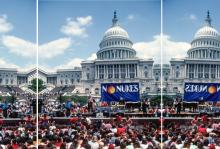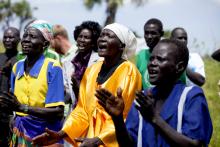Commentary

IN MINNESOTA, Alec Smith was unable to afford either health insurance premiums or the insulin needed to treat his Type 1 diabetes, despite working full time. He died last year from diabetic ketoacidosis, at age 26. Other young Americans with diabetes have suffered the same fate.
David Bridges of Indiana has health insurance through his job, but a high deductible means he has to pay for his multiple prescriptions out of pocket. One of those prescriptions alone costs $700 a month. He maxes out credit cards to buy what medicine he can, yet still has to skip doses.
These stories represent the status quo of U.S. health care, even with the preservation of the Affordable Care Act. In responding to such gaps, the faith community has traditionally turned to the direct provision of charity health care, a generous hallmark of our traditions for generations. But we cannot stop there.

FROM THE STREETS of Ferguson to Charlottesville and from Occupy to Standing Rock, anarchists represent a prominent part of today’s activist mix. How might Christians understand this tradition of political engagement?
In popular culture, anarchism is often trivialized as a cipher for generalized chaos, based on a caricature of hooded black bloc brawlers smashing store windows at protests. On the other hand, some anarchists settle for mere sloganeering, with little analysis or strategy. But simplistic stereotypes fail to recognize that, as social critic Cornel West put it, anarchism represents “a powerful critique of concentration of power in the nation-state.”
The label derives from the Greek anarchos, meaning “without rulers” (not, as some libertarians wrongly assume, without rules). Anarchists work for voluntary, nonhierarchical forms of self-organization and against state coercion and oppression.
As a social movement and ideological orientation, political anarchism began coalescing in the wake of the failed social revolutions of 1848 around Europe. Early anarchists critiqued the state as the root of all human oppression, and as the “left of the left” challenged Marxist assumptions that revolutions could only be accomplished by changing state structures from the top down. Some proposed communal self-rule and “mutual aid” as an alternative to social Darwinism.
The majority of the tradition was (and remains) decidedly atheist—“no gods, no masters.” But Pierre-Joseph Proudhon allowed that early Christianity was essentially anarchist until the church sold out to Constantine, while Peter Kropotkin argued the same about popular radical religious movements of the late Middle Ages.

CERTAIN STRAINS of consumerism are easy to spot. Think Beverly Hills and walls stacked with brightly colored shoes and purses, like heaps of fresh produce. Closer to home, perhaps, is the caricature of suburban consumption—gas-guzzling SUVs, expensive outerwear.
And then there’s minimalism, an ideology defined by its emphasis on intentional efforts to spend less. At its best, minimalism provides a healthy alternative for people of faith seeking simplicity and thoughtful economic practices. At its worst, the minimalist aesthetic looks an awful lot like the system it was designed to critique—oblivious, privileged, and disconnected from reality.

IN MARCH, I visited Cuba on a 10-day tour with alumni from Eastern Mennonite University. I’ve studied the socialist structure of the early Jerusalem church (as recounted in Acts 2-6), and I wanted to experience Cuban socialism directly and see how it compares. How, for example, have Christian churches fared under a one-party socialist government?
On our visit, we heard about Cuba’s successes in the areas of health care and education. We heard a lecture on the massive effort to bring Cuba’s average level of education from third grade in 1959 to the current 11th grade. We learned about Cuba’s universal free health care, and that local clinics throughout the island provide basic care accessible to every citizen. As a result, infant mortality is lower than in the U.S. and overall life expectancy is about the same, according to The Atlantic—even though the U.S. spends more than 10 times as much per person per year on health care.
Such basic needs have been met not by Christian churches but by a government that initially robbed the wealthy and shared it with the poor. What were Christians in Cuba—Catholics, Protestants, Anabaptists, and Jehovah’s Witnesses—to make of this enormous shift toward economic equality? After the revolution, most missionaries returned to their home countries, and thousands of Cubans, Christians and otherwise, fled to the United States. Christians who remained had to rethink their mission in a society where the poor were educated and healed through structural change rather than individual charity.

THE ARREST OF SEVEN Catholic activists from the Plowshares movement who entered a nuclear submarine base in April again highlights the enduring threats posed by nuclear weapons. The Kings Bay Plowshares carried religious banners promoting peace onto the naval base in Georgia that houses Trident submarines armed with missiles with nuclear warheads. “This weapons system is a cocked gun being held to the head of the planet,” the activists said in a statement as they were arrested.
At a time when President Trump reportedly told Russian President Vladimir Putin that the U.S. would win a nuclear arms race between the two countries, nuclear disarmament efforts feel tenuous. Former U.S. Secretary of Energy Ernest Moniz, who helped broker the Iran nuclear agreement, has warned that the chance of a nuclear launch is “higher than it’s been since the Cuban missile crisis.”
Against this backdrop, the clock is ticking on the New Strategic Arms Reduction Treaty signed in 2010 by President Obama and Russia’s then-President Dmitry Medvedev that limits strategic warheads and delivery systems in the two countries. Unless action is taken to extend that agreement, it will expire in 2021. If that happens, for the first time in more than 40 years the U.S. and Russian nuclear arsenals would operate free of an arms control agreement.
The Pentagon released a nuclear arms policy in February that requests two new types of nuclear weapons, essentially ending the Obama administration’s efforts to reduce the U.S. nuclear arsenal. Defense Secretary Jim Mattis described the changes as a need to “look reality in the eye” and to “see the world as it is, not as we wish it to be.”

MOST PEOPLE RESPOND to incentives. A lower price. A deadline. Chocolate pudding after you eat your vegetables.
Big companies respond to incentives, too, such as tax breaks or lower costs of inputs.
Remarkably, Danone Corp. has created its own incentives to step up its positive-impact game by getting lenders to agree to lower the price of money Danone borrows if it meets a range of socially beneficial goals. And, even more remarkably, in February, 12 global banks agreed.
Based in France, Danone makes and sells Dannon yogurt and other dairy products, infant and medical nutrition, and bottled water—a $2-billion-dollar industry. Any seller of bottled water and infant formula has and deserves critics, and although the company has far to go in serving the social good, it has come a long way. Danone focuses on environmentally sound sourcing, packaging development, and recycling, as well as employee well-being. Several of its subsidiaries are B Corporations, meaning they annually pass an independent, in-depth evaluation of how well they serve all stakeholders, including employees, customers, communities, and watersheds—not just shareholders, the only constituency that drives most businesses.
According to the lending deal, as reported in Forbes, Danone’s cost of capital will rise or fall with the percentage of its sales from B- Corp subsidiaries. Doing more business with all stakeholders in mind will result in cheaper loans to meet operating expenses and to invest in new business. In addition, Danone’s environmental, social, and governance (ESG) performance will be evaluated by other third-party monitors. A greenwashed annual report will not suffice.

SOUTH SUDAN is the world’s youngest and most fragile state. The outbreak of civil war in 2013 pushed millions out of the country and into refugee camps. Oil revenues fuel President Salva Kiir’s regime, notorious for kidnapping and torturing those who criticize him.
Kiir’s suppression hasn’t stopped courageous Christian women from taking their prayers for peace to the streets. On the first Saturday of every month, hundreds of women gather to demand an end to war.
“All 64 tribes are represented in the women’s division of the South Sudan Council of Churches,” said Maria Bol (not her real name), a member of the ecumenical body responsible for organizing the marches. “The challenge in South Sudan is that the government has no tear gas. They just use live bullets against peaceful protesters. But our actions often go on uninterrupted, since they know we are peaceful and prayerful.”
Although the international media portrays South Sudan’s women and youth as passive victims of their tragic circumstances, it is exactly these demographics that are pushing back against this brutal regime. In November, youth members of more than 40 women’s organizations convened the largest anti-war demonstration since the war began. Thousands turned up, wielding messages of peace while Kiir’s national security forces—responsible for intimidating and abusing his critics—attempted to single out leaders.
These leaders continue to suffer—some even being intimidated in the neighboring countries to which they fled—and threats continue against their family members back home.

FIVE HUNDRED YEARS after Martin Luther’s charge semper reformanda (“always reforming”), we stand on the precipice of climate disaster.
In Marrakesh, Morocco, people of faith met at the 2016 U.N. Climate Change conference (COP22) to face an impending climate disaster—a disaster that now seems likely to be exacerbated by U.S. political leadership rather than mitigated by it.
The World Council of Churches held an event in Marrakesh to emphasize how transitional justice- and rights-based approaches, alongside faith-based moral perspectives, can address challenges as complex as natural-resource management and ecological, humanitarian, and spiritual crises exacerbated by climate change. WCC organizer Henrik Grape hoped that “COP22 will take steps forward to fulfill the expectations from Paris and that nations will raise their ambitions to keep the temperature [rise] well under 2 degrees Celsius.”
A wide variety of church bodies were represented at the gathering. The Lutheran World Federation brought youth delegates from Africa to Marrakesh to promote intergenerational collaboration and solidarity with people most affected by climate change. “One of our thematic approaches to the commemoration of 500 years of Lutheran Reformation is the theme ‘Creation: Not For Sale,’” said Caroline Bader, youth secretary for the federation. The Act Alliance, a coalition of 143 churches and parachurch organizations, established a gender-climate change working group to address sustainability among poor and marginalized people through a gender lens.
Catholic theologian Guillermo Kerber believes that Pope Francis’ encyclical on the environment is a turning point for the social doctrine of the Catholic Church, by including ecology in the social concerns of Catholics. “The celebration of the 500 years of the Reformation should be an opportunity to express an ecological conversion of all Christian denominations,” said Kerber.

LAST DECEMBER, my daughter, Zipporah—who has taken to acting out the Christmas story using our wooden nativity set—observed that our crèche was missing a “mean king” figurine. That got me to thinking: I have never seen a nativity set with a King Herod figure.
We tend to close the curtains and go home for a family dinner right after the Magi bow before Jesus with their gifts of gold, frankincense, and myrrh.
But after the Magi head home, Joseph is warned in a dream to escape Herod’s genocidal tyranny by fleeing to Egypt with his wife and child.

DONALD TRUMP HAS released many bizarre and disturbing tweets in recent months, none more alarming than his statements in December that the “U.S. must greatly strengthen and expand its nuclear capability” and “Let it be an arms race. We will outmatch them at every pass and outlast them all.”
Commentators were dumfounded by the messages, which seemed to come out of nowhere, and dismissed them as bluster not to be taken seriously. The tweets were deeply troubling, however, and indicate that the new president is ignorant of nuclear realities and intent on ratcheting up nuclear spending and challenging others to keep up.
Thankfully, the potential competitors in such a contest seem uninterested. Russian President Vladimir Putin announced during his annual press conference the day after Trump’s messages that Russia will reduce military spending next year as it adjusts to economic recession at home. China has indicated no change in its longstanding policy of maintaining a small but capable nuclear force. Trump may be ready for an arms race, but as of now his rivals seem to have no interest in running.
Nuclear bravado can change these calculations, however, especially if it is accompanied by substantial increases in spending for new weapons. Trump has promised to give more money to the military and bolster nuclear capability. U.S. weapons makers Boeing and Lockheed are competing for multibillion-dollar contracts to replace and upgrade the U.S. land-based missile force. Former Defense Secretary William Perry has argued that the plan to rebuild nuclear missiles is wasteful, unnecessary, and dangerous.

RELIGION IS AN EASY language for people to use to define conflict. The people most willing to speak about what religion demands are the ones least likely to be invested in the sacrifices religion requires. They want the power that they believe they can claim through religion.
Those same voices who engage in this idle worship now hold the reins of power in the U.S. government. And they seek to exterminate Muslims. There are concerns of a Muslim registry and internment camps. More extreme fears consider other types of camps, imagining a return of the Holocaust. These fears are not unfounded, nor are they out of character with what President Trump’s advisers and appointees have said.
Yet these parallels are so powerful that I think it may be difficult for them to be realized. What I think is more likely in the near term is a different historical parallel. At the waning of another empire, the Colosseum became a space where individuals were martyred for what they believed, for entertainment.
An individual loss may be horrible, but the individual’s community may still believe it is safe. But death can come by a thousand cuts. The lion that chooses one life at a time remains a ravenous beast—the whole community will be vilified and will eventually die, just not quickly. And that beast will need a new food source.
The mayor of New York announced a 35-percent increase in hate crimes in the city in the month following the election. During that time there were 43 hate crimes documented. In December, a Muslim Metropolitan Transportation Authority worker wearing her uniform and a hijab was pushed down a flight of stairs at Grand Central station, and a Muslim police officer was threatened, in front of her teenage son, with having her throat slit. In August, two Muslim leaders were shot to death after leaving prayers at their mosque. For years, the New York police department has spied on Muslims where we pray.

IN DECEMBER 2014, the United Nations approved a resolution put forth by Bangladesh and more than 100 other countries that included a reference to “unarmed civilian protection.” This was the first time the phrase had been referenced in an official U.N. General Assembly document.
The following year, a U.N. report noted that “unarmed civilian protection is a method for direct protection of civilians and violence reduction that has grown in practice and recognition. In the last few years, it has especially proven its effectiveness to protect women and girls.”
Last fall, Tiffany Easthom, executive director of Nonviolent Peaceforce, addressed a special U.N. session on unarmed civilian protection with a bold proposal: “The [U.N.] Security Council could ensure the centrality of unarmed strategies in protection of civilian mandates.”
Unarmed civilian protection, or UCP, is just what it sounds like: nonviolent action by civilians to protect other civilians from political violence. The peacekeeping practice is rooted in the call for a “peace army”—a Shanti Sena—by Mohandas Gandhi and Khan Abdul Ghaffar Khan, whom the pope referenced in his 2017 World Day of Peace message.
Peace Brigades International is generally credited with initiating the current practice in the 1980s in Guatemala. Peace Brigades International focused on specific strategies based on the principles and practices of nonviolence, the primacy of local actors, independence, and for many but not all organizations, nonpartisanship, in an organized, disciplined way.
Many organizations around the world are currently practicing this method of intervention, including Peace Brigades International, Nonviolent Peaceforce, Christian Peacemaker Teams, SweFOR, Meta Peace Team, Operation Dove, Ecumenical Accompaniment Programme in Palestine and Israel, the Presbyterian Peace Fellowship, and others.

ONE SPACE WHERE I find rest, amid the noise of living and working in Washington, D.C., sits directly in the heart of the hustle: the Newseum, dedicated to the defense of Amendment 1 to the U.S. Constitution.
It may be an odd choice, since it exhibits the front page of 60 newspapers each morning, each listing the harrowing headlines I’m trying to escape. But in this space, dedicated to education on our First Amendment freedoms, I find special solace.
Etched on a large window overlooking Pennsylvania Avenue between the White House and the Capitol are these words: “Freedom of Press Speech Religion.”
There is not much breathing room between those freedoms inherent to all Americans, nor between those listed separately: freedom of assembly and petition.
It’s a well-placed reminder about freedoms many Americans take for granted. In 2016, 39 percent of Americans could not name a single one of them. Fifty-four percent could name freedom of speech, but only 17 percent and 11 percent could name freedom of religion and freedom of the press, respectively.
When freedoms don’t “feel” threatened, it’s easy to take them for granted.
Enter 2017. Already this year, we’ve experienced attacks on the freedom of religion as evidenced by the surge in Islamophobic and anti-Semitic attacks and the Trump administration’s failure to mention Jews or anti-Semitism in its Holocaust Remembrance Day statement (a stark departure from the previous six administrations). We’ve seen lawyers spill pro bono hours in airports defending the freedom of religion by enforcing legal protections for international travelers in the face of what appeared to be a “religious test” for entering the country.
People of faith across the U.S. and across party lines rightly have been outraged at potential infringement of religious liberty under the Trump administration.

I GREW UP dazzled by NBA champion Kobe Bryant taking over games and redefining precision—I could never look away when he was on the court. But the sexual assault accusations brought against him in 2003 are as much a part of Bryant’s legacy as the night he dropped 81 points on the Toronto Raptors.
Domestic violence and sexual assault cast a long shadow over athletics, as much in Christian colleges as in secular universities or professional sports. Christian colleges should be held to a higher standard, however, because they have a gospel mission to shape disciples and protect the vulnerable, not just trade in talent.
That’s why I was dismayed in November when Liberty University (“Training Champions for Christ since 1971”) hired Ian McCaw as its new athletic director. McCaw resigned from Baylor University last year after he was sanctioned and placed on probation for his role in a widespread sexual assault scandal. The investigation into McCaw’s negligence led an independent law firm to release “scathing findings” of an “overall perception that football was above the rules,” and a complete lack of a “culture of accountability for misconduct.”
Liberty President Jerry Falwell Jr.’s response? McCaw’s tenure at Baylor “fits perfectly with where we see our sports programs going.”
Professional sports are notorious for an institutional failure to hold sports figures accountable and to believe, respect, and protect victims of physical and sexual violence by those same figures. The NFL famously prioritizes player talent over women’s safety and imposes punishment to offenders unevenly—an inconsistency that often has a racialized narrative.

REMEMBER WHEN the Kony 2012 video went viral? The short documentary, produced by the controversial Invisible Children organization about brutal Ugandan rebel Joseph Kony and the Lord’s Resistance Army, purportedly reached more than half of young adults in the U.S. when it was released. Young Christians across the country swarmed their elected representatives, urging action against Kony, which quickly legitimized Obama’s deployment of U.S. military forces to hunt a relatively idle madman with depleted resources.
Since then, U.S. militarization in Africa has shown no sign of slowing. In 2006, according to The Intercept, “just 1 percent of [U.S.] commandos sent overseas were deployed in the U.S. Africa Command [AFRICOM] area of operations. In 2016, 17.26 percent of all U.S. Special Operations forces ... deployed abroad were sent to Africa.” The U.S. admits to the existence of one permanent base in Africa, in Djibouti on the Gulf of Aden, while U.S. special forces are deployed in “more than 60 percent of the 54 countries on the continent.”
Special operations and collaborations with proxy militias enable U.S. militarism in Africa to persist with very little public awareness or oversight—and wreak havoc on local populations.
“By keeping us in a state of perpetual war, the arms trade grows,” said Norman Tumuhimbise, a Ugandan youth activist kidnapped and tortured in 2015 by a branch of Uganda’s military that trains under U.S. anti-terror programs.

HOW DOES ONE celebrate the glorious resurrection of Jesus Christ while crippled with fear?
There have been a handful of times in my life of faith that have been filled with sadness. One of those was in November when, according to research, 81 percent of white evangelical Protestants and 52 percent of white Catholics—enthusiastically or not—decided to vote for a president with a platform hostile to the teachings of Jesus. A debilitating fear and despair began burrowing into the marrow of my bones. It’s hard to await the next executive order or policy change or nomination that will instill fear in my community.
As a health-care chaplain and student in public health, I’m keenly aware of the impact repeal of the Affordable Care Act would have on access to basic health care and in the lives of people I’ve worked with in hospitals from coast to coast. With the ACA, a young cancer survivor will still be eligible for insurance; thousands do not have to worry about “lifetime caps” on benefits, and will not have to file for bankruptcy because their premiums skyrocketed. I have sat at the bedside of thousands who have fought to survive their illness. Now they are targeted.
Alone, it’s easy to become lost in the distortion brought on by hate rhetoric. I need to connect to something with deeper roots than my fear.

THE DEATH PENALTY is almost dead in America. It’s time to pull the final plug.
The number of death sentences imposed is the lowest it’s been in 40 years, and the number of executions is the lowest it’s been in 20. Every year another state abolishes the death penalty. Just this summer Delaware’s highest court declared its death penalty unconstitutional. Several more states are poised to do the same. In fact, only a handful of states are actually still executing. This year Texas and Georgia accounted for 80 percent of the executions.
Most Americans have moved on from the death penalty. When presented with alternatives, a majority of the population says they are against it.
The question is not if we will abolish the death penalty, but when. With the vacancy on the Supreme Court, we are at a critical tipping point. We will someday look back at the death penalty like we look back at slavery, asking, “How did we think that was okay?”
But where will Christians be as this history is made? It’s troubling that the death penalty has succeeded in the U.S. because of Christians, not in spite of us. Eight out of every 10 executions in the past four decades have been in the Bible belt. Where Christians are most concentrated is where capital punishment has flourished. Strange, isn’t it? One would think that those of us who worship a victim of state-sanctioned execution would be suspicious of state violence, that we’d be its biggest critics. But that’s not always the case.
But here’s the deal: I’m hopeful. Only 5 percent of Americans think Jesus would support the death penalty. Christians born after 1980 are overwhelmingly opposed to it. The National Association of Evangelicals has pulled back on its support and the National Latino Evangelical Coalition has called for total abolition. A growing movement of faith-fueled conservatives is leading the way to alternatives to the death penalty in states such as Nebraska, where a referendum to retain a death-penalty ban is on the upcoming ballot. The Movement for Black Lives lists ending capital punishment as one of its top needed reforms. And, as part of the year of mercy, Pope Francis issued a clarion call for a global moratorium.

THE CONTROVERSIAL Jan. 29 attack by U.S. forces on a rural township in Yemen exemplifies the failed U.S. policy in the region.
In the first military raid carried out by the Trump administration, one U.S. soldier and at least 25 civilians were killed in the attack on the village of al-Ghayil in central Yemen, including nine children under the age of 13. Among these was 8-year-old Nawar al-Awlaki, an American citizen, who was shot in her family’s house. Other civilians killed included visitors whose family has been active in U.N.-mediated de-escalation committees, working to quell violence in the region.
Some leaders of al Qaeda in the Arab Peninsula (AQAP) also lived in al-Ghayil. AQAP has taken advantage of Yemen’s multi-sided civil war to find refuge in remote areas. AQAP maintains an uneasy relationship with local tribes, many of whom abhor al Qaeda’s violent excesses and reactionary interpretation of Islam but respect AQAP’s ability to fight common enemies.
When Navy SEALs found themselves under fire, they called in airstrikes. The barrage hit houses where families slept, killing people and livestock. Navy SEAL William “Ryan” Owens was also killed.
President Trump initially blamed his own generals and former President Obama for the botched raid. Then, in his first address to Congress, Trump pivoted, describing it as “a highly successful raid that generated large amounts of vital intelligence.” Owen’s widow was present; Trump referred to her multiple times in his address. Owen’s father refused to meet with the president and asked for an investigation into his son’s death.

THE CIVIL RIGHTS movement. #BlackLivesMatter. Racial reconciliation. It would be easy for me to imagine the words of Eliza in the musical “Hamilton” and sing, “I’m erasing myself from the narrative.”
At first glance, those statements, movements, and conversations might be mistakenly boiled down to division and brokenness between two Americas—one black, one white.
But I’m neither. I’m “yellow.”
I didn’t choose to erase myself in history, but it’s what I learned. Asian Americans weren’t erased from American history as much as we just didn’t exist in the Plymouth Rock story of East Coast immigration, with its emphasis on Europe’s poor and hungry “huddled masses.” We learned that “assimilation” was as much about becoming “white” as it was about becoming “American.” We learned that the civil rights movement was a fight for equal rights for black Americans, with little connection to “others” like myself. There was no category for someone who looked like me unless it was Oriental, chink, or gook—racial slurs I first heard as a child on suburban playgrounds (and still hear as an adult), slurs tied to a history and wars I knew very little about. In America, race is a social construct divided most simply between black and white.
I also learned that the best I could hope for was to become a model minority, an “honorary white” who would never be considered a “real” American.
So I just didn’t become one. In an act of rebellion, I chose not to become a naturalized U.S. citizen until a few years ago. In the process I learned what it means to opt into a binary conversation with a different, clear, defined perspective. I needed to learn who I was, created as a Korean-American woman carrying God’s image. I needed to learn that Jesus, Mary, Martha, and Esther weren’t blue-eyed or blonde.

FOR THE PAST three years, Pope Francis has convened leaders of grassroots movements from around the world to extend the church’s solidarity with the poor and vulnerable on three critical themes: land, work, and housing.
This winter, a regional gathering of the World Meeting of Popular Movements met in the United States for the first time. Seven hundred grassroots leaders, accompanied by 25 U.S. Catholic bishops, several international representatives, and a delegation from the Vatican, led by Cardinal Peter Turkson, met in Modesto, Calif., with the cardinal bearing a letter of support, invitation, and challenge from Pope Francis.
To the regular themes, U.S. leaders added racism and migration. Participants addressed the pain of exclusion from the perspective of undocumented domestic workers, residents of Flint whose water was contaminated, Standing Rock water protectors, and the unhoused, while also raising the hope of united, faith-rooted, nonviolent resistance.
Racial justice, in the U.S. and abroad, was a central theme. “Why is blackness a threat in America?” asked Rev. Traci Blackmon. “And how are we, as people of color, ever to be perceived as unarmed, and therefore nonthreatening, if our blackness is the weapon that you fear?” Blackmon said that oppression, dehumanization, and racism are rooted in the original sin of desiring to be God and seeking to create God in our own image. John A. Powell, director of the Haas Institute for a Fair and Inclusive Society, added, “When you ‘other’ someone in an extreme way, then you treat them as a non-human.”